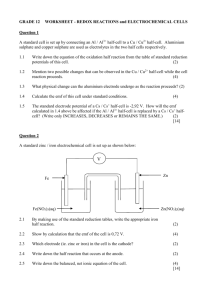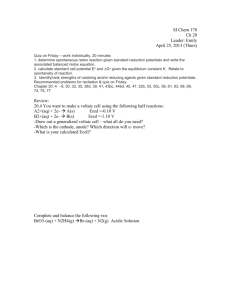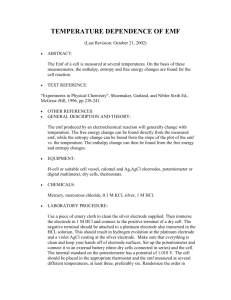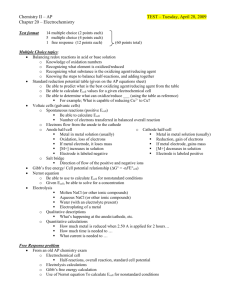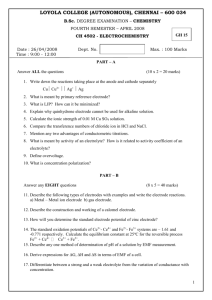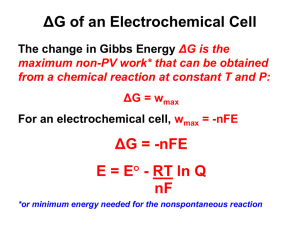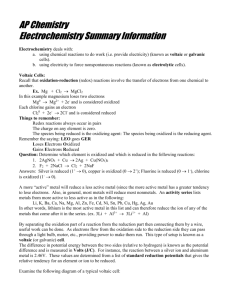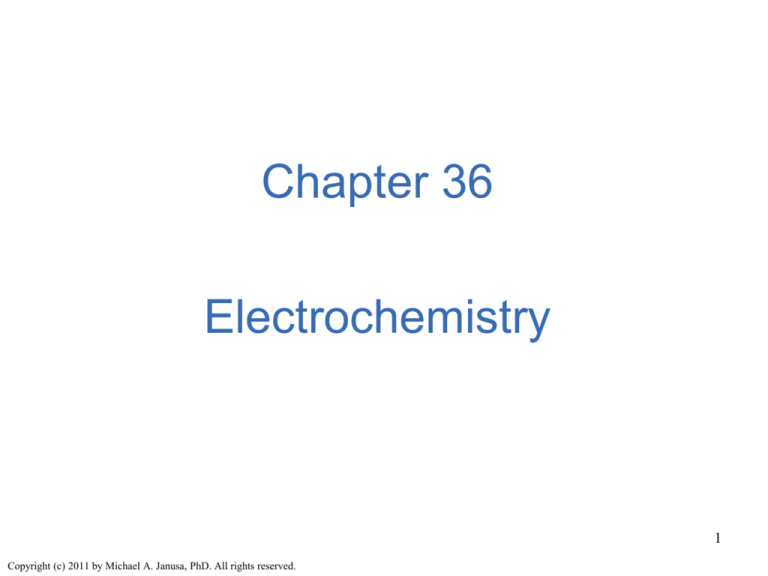
Chapter 36
Electrochemistry
1
Copyright (c) 2011 by Michael A. Janusa, PhD. All rights reserved.
36.1 Oxidation-Reduction Reactions
• Back in general chemistry I and the beginning
of this semester we covered the halfreaction method for balancing oxidationreduction reactions.
– Oxidation-reduction reactions always involve a
transfer of electrons from one species to
another.
– oxidation - lose electron - higher ox state
Fe2+ Fe3+ + 1e– reduction - gain electrons - lower ox state
Fe3+ + 1e- Fe2+
2
Oxidation-Reduction Reactions
– An oxidizing agent is a species that oxidizes
another species; it is itself reduced.
– A reducing agent is a species that reduces
another species; it is itself oxidized.
Loss of 2 e-1 oxidation
reducing agent
Fe( s ) Cu
2
( aq )
Fe
2
( aq )
oxidizing agent
Cu( s )
Gain of 2 e-1 reduction
red : Cu
2
( aq )
2e Cu ( s )
2
ox________________________
: Fe( s ) Fe ( aq ) 2e
Fe( s ) Cu
2
( aq )
Fe
2
( aq )
Cu( s )
3
Oxidation-Reduction Reactions
• In this chapter we will show how a cell is constructed to
physically separate an oxidation-reduction reaction
into two half-reactions.
red : ( Ag
Ag(s) Cu
AgNO3(aq)
e-
( aq )
1e Ag ( s ) )2
2
ox
:
Cu
Cu
2
e
( aq )
(s)
________________________
Cu2+
Cu Cu2+
Ag+ Ag
ox
red
Cu ( s ) 2 Ag ( aq ) Cu 2 ( aq ) 2 Ag ( s )
electrochemical cell
– The force with which electrons travel from the
oxidation half-reaction to the reduction halfreaction is measured as voltage (actually
produces electricity).
4
Electrochemistry
• An electrochemical cell is a system consisting of
electrodes that dip into an electrolyte in which a
chemical reaction either uses or generates an electric
current.
– A voltaic, or galvanic, cell is an electrochemical
cell in which a spontaneous reaction generates
an electric current (+V, rxn occurs on own).
– An electrolytic cell is an electrochemical cell in
which an electric current drives an otherwise
nonspontaneous reaction (-V, rxn does not occur
on own, need outside source).
5
36.2 Voltaic Cells
• A voltaic cell consists of two half-cells that
are electrically connected.
– Each half-cell is a portion of the electrochemical
cell in which a half-reaction takes place. No
reaction between species involved just a transfer
of electrons.
– A simple half-cell can be made from a metal strip
dipped into a solution of its metal ion.
– For example, the silver-silver ion half cell consists
consists of a silver strip dipped into a solution of a
silver salt.
electrode
Cu
Ag
AgNO3
6
Figure :
Voltaic cell
consisting
of cadmium
and silver
electrodes.
volt
meter
or light
oxidation
KCl
Cd(NO3)2
Ebbing, D. D.; Gammon, S. D. General
Chemistry, 8th ed., Houghton Mifflin, New
York, NY, 2005.
reduction
AgNO3
7
Voltaic Cells
– In a voltaic cell, two half-cells are connected in such a
way that electrons flow from one metal electrode to
the other through an external circuit.
– This cell has Ag reduced and Cd oxidized.
– Cathode red: [Ag+ + 1e- Ag (s)] 2 (must happen twice)
– Anode ox: Cd (s) Cd2+ + 2 e– overall: 2Ag+ + Cd (s) 2 Ag (s) + Cd2+
is the net reaction that occurs in the voltaic cell; it is
called the cell reaction
– Note that electrons are given up at the anode (-)
and thus flow from it to the cathode (+) where
reduction occurs.
8
Voltaic Cells
• As long as there is an external circuit, electrons
can flow through it from one electrode to the other.
– Because cadmium has a greater tendency to
lose electrons than silver, cadmium atoms in the
cadmium electrode lose electrons to form
cadmium ions.
– The electrons flow through the external circuit to
the silver electrode where silver ions gain the
electrons to become silver metal.
– The anode (oxidation) in a voltaic cell has a negative
sign because electrons flow from it.
The cathode (reduction) in a voltaic cell has a positive
sign
9
Voltaic Cells
• The two half-cells must also be
connected internally to allow ions to flow
between them and complete the circuit.
– Without this internal connection (salt bridge), too
much positive charge builds up in the cadmium
half-cell (and too much negative charge in the
silver half-cell) causing the reaction to stop (must
have counter ion to balance charges). KCl salt
bridge is present for this purpose.
10
Figure : Two electrodes are connected by
an external circuit.
ox
Cl- Cl-
Ebbing, D. D.; Gammon, S. D. General
Chemistry, 8th ed., Houghton Mifflin, New
York, NY, 2005.
red
K+ K+
NO3NO3Cu(NO3)2
11
Voltaic Cells
• A salt bridge is a tube of an electrolyte in a gel that
is connected to the two half-cells of a cell.
– The salt bridge allows the flow of ions but
prevents the mixing of the different solutions
that would allow direct reaction of the cell
reactants.
– completes circuit
– keeps electrostatic neutral
12
–The voltage produced is from the potential
difference between the two metals at any instant. It
is a measure of the tendency of the cell reaction to
proceed toward equilibrium.
–Equil is driving force of reaction. As reaction
proceeds, potential difference decreases
continuously and approaches zero as equil is
approached.
–Not infinite amount of electricity. When reach equil
have 0V. The conc . of species has effect on equil
and the amount of voltage. Further away from equil,
the higher the potential difference.
13
36.2.1 Electrochemical Cell Notation
• It is convenient to have a shorthand way of
designating particular cells.
– The cell consisting of the cadmium-cadmium ion
half-cell and the silver-silver ion half-cell, is written
2
Cd ( s ) | Cd (aq ) || Ag (aq ) | Ag ( s )
anode
(ox)
salt bridge
cathode
red
– The anode (oxidation half-cell) is written on the left. The
cathode (reduction half-cell) is written on the right.
– Double line indicates salt bridge is present but not always
present; both half reactions can be in same container.
14
2
2
Zn(s ) | Zn (aq ) || Cu (aq ) | Cu(s )
anode
salt bridge
cathode
– The cell terminals are at the extreme ends in the
cell notation (electrode metal).
– A single vertical bar indicates a phase boundary,
such as between a solid terminal and the
electrode solution (states usually omitted).
red : Cu 2 ( aq ) 2e Cu ( s )
2
ox : Zn
Zn
2
e
(
aq
)
(s)
____________________
Zn( s ) Cu 2 ( aq ) Cu ( s ) Zn 2 ( aq )
15
Notation for Cells
• When the half-reaction involves a gas, an inert
material such as platinum or carbon serves as a
terminal and the electrode surface on which the
reaction occurs.
– Example is the hydrogen electrode; hydrogen
bubbles over a platinum plate immersed in an
acidic solution.
– The cathode half-reaction is
2H (aq ) 2e H 2 (g )
Slide 59
16
Notation for Cells
– The notation for the hydrogen electrode,
written as a cathode, is
anode
||
H (aq ) | H 2 (g ) | Pt
Sometimes written as
SHE (1atm, 1M)
– To write such an electrode as an anode,
you simply reverse the notation; want
terminal as extreme end.
cathode
Pt | H 2 (g ) | H (aq ) ||
17
Notation for Cells
• To fully specify a cell, it is necessary to give the
concentrations of solutions and the pressure of
gases.
– In the cell notation, these are written in
parentheses. For example,
2
Zn | Zn (1.0 M ) || H (1.0 M ) | H 2 (1.0 atm) | Pt
eZn
+
Pt
H2 1atm
Zn2+ 1M
ox
anode
H+ 1M
red
cathode
ox:
red:
Zn Zn2+ +2e2H+ +2e- H2
Eo
Eo
2H+ + Zn Zn2+ + H2 Eocell
note: spectator ions are not usually present in short notation.
This is an example of a standard cell: 1M, 1atm, 25oC (298K) 18
e-
Cd
+
Pt
H2 1atm
Cd2+ 1M
ox
anode
H+ 1M
red
cathode
• Draw cell and write the overall cell reaction for
the given cell
2
Cd ( s ) | Cd (1.0 M ) || H (1.0 M ) | H 2 (1.0 atm) | Pt
– The half-cell reactions are
2
anode ox:
cath red:
Cd(s ) Cd (aq ) 2e
2H (aq ) 2e H 2 (g )
2
Cd(s ) 2H (aq ) Cd (aq ) H 2 (g )
Eo
Eo
Eocell
19
Electromotive Force
• Potential difference, Ecell, is the
difference in electric potential (electrical
pressure) between two points.
– You measure this quantity in volts.
– The volt, V, is the SI unit of potential
difference equivalent to 1 joule of energy
per coulomb of charge.
1 volt 1 J
C
20
Electromotive Force
• The Faraday constant, F, is the magnitude
of charge on one mole of electrons; it equals
96,500 coulombs (9.65 x 104 C).
1 F = 96,500 C = charge of 1 mole e– In moving 1 mol of electrons through a circuit, the
numerical value of the work done by a cell is the
product of the Faraday constant (F) times the
potential difference between the electrodes.
work(J) F(coulombs ) volts(J/coulomb )
work done by the system
21
Electromotive Force
– In the normal operation of a voltaic cell, the potential
difference (voltage) across the electrodes is less
than the maximum possible voltage of the cell.
– The actual flow of electrons reduces the electrical
pressure; therefore, slightly lower voltage obtained.
22
Electromotive Force
• electromotive force (emf) of the cell,
or Ecell - the maximum potential
difference between the electrodes of a
cell.
– It can be measured by an electronic digital
voltmeter.
23
Standard Cell emf’s and Standard
Electrode Potentials
• A cell emf is a measure of the driving
force of the cell reaction.
– The reaction at the anode has a definite oxidation
potential, while the reaction at the cathode has a
definite reduction potential.
– Thus, the overall cell emf is a combination of
these two potentials.
Ecell = reduction potential, Ered + oxidation potential, Eox
24
Standard Cell emf’s and Standard
Electrode Potentials
– A reduction potential, Ered, is a measure
of the tendency to gain electrons in the
reduction half-reaction.
Ered
A+ + 1e- A (s)
E=xV
– You can look at the oxidation half-reaction as the
reverse of a corresponding reduction reaction.
– The oxidation potential, Eox, for an
oxidation half-reaction is the negative of
the reduction potential for the reverse
reaction. E
A (s) A+ + 1e- E = -x V
ox
25
36.3 Standard Electrode Potentials
• By convention, the Table of Standard (1M, 1atm,
25oC) Electrode Potentials are tabulated as
reduction potentials (all).
– Consider the zinc-copper cell described earlier,
calculate the Eocell.
2
Slide 44
Slide 28
Slide 27
2
Zn ( s ) | Zn (1M ) || Cu (1M ) | Cu ( s )
– The two half-reactions are
2
ox : Zn ( s ) Zn (aq ) 2e
2
Eo = 0.76V (changed sign from table)
o = 0.34V
E
red : Cu (aq ) 2e Cu ( s )
_________________________________________
Zn + Cu2+ --> Zn2+ + Cu
Eocell = 1.10 V voltaic, spon
This voltage for standard cell: 1M otherwise need to correct from std conc of 1M.
Note table is electrode potentials for standard (superscript o: 1M, 1atm, 298K) 26
reducing agent
oxidized
All are reductions;
Flip and change sign
for oxidation
Std: 1M, 1atm, 25oC
reduced
H: reference electrode
Cu Cu2+
Ag+ Ag spon
Slide 26
Slide 33
oxidizing agent
27
Ebbing, D. D.; Gammon, S. D. General Chemistr
8th ed., Houghton Mifflin, New York, NY, 2005.
Standard Cell emf’s and Standard
Electrode Potentials
– The electrode potential is an intensive
property whose value is independent of
the amount of species in the reaction.
28
Standard Cell emf’s and Standard
Electrode Potentials
– Thus, the electrode potential for the half-reaction
Cu 2 (aq ) 2e Cu(s )
Eo = 0.34V
is the same as for
2Cu 2 (aq ) 4e 2Cu(s )
Recall:
K
DH
Eo
flip
n factor
flip
n factor
1/K
Kn
- DH
n DH
flip
n factor
- Eo
Eo
Eo = 0.34V
29
36.3.1 Standard Cell Electrode Potentials
• The standard emf (theoretical potential),
E°cell, is the emf of a cell operating under
standard conditions of concentration (1 M),
pressure (1 atm), and temperature (25°C).
– Note that individual electrode potentials require that
we choose a reference electrode.
– arbitrarily assign this reference electrode a potential
of zero and obtain the potentials of the other
electrodes by measuring the emf’s. These are
relative values not absolute.
30
Tabulating Standard Electrode Potentials
– By convention, the reference chosen for comparing electrode
potentials is the standard hydrogen electrode (SHE).
– Standard electrode potentials are measured relative to this
hydrogen reference as the anode.
– For example, when measure the emf of a cell composed of a
zinc electrode connected to a hydrogen electrode, you
obtain 0.76 V with hydrogen being cathode and zinc as anode
for the spon rxn. By definition, we want the comparison of
hydrogen to other species to be hydrogen as anode and the
other species as cathode; Since hydrogen is given zero value
all voltage measured is given to zinc but we must change sign
for reduction value of zinc as defined in table.
– Since zinc acts as the anode (oxidation) in this spon cell, its
reduction potential is listed as –0.76 V. This means that zinc
has a potential that is 0.76 less than hydrogen (relative not abs)
31
36.4 Predicting the Spontaneous Direction
of a Redox Reaction
• Standard electrode potentials are useful in determining the
strengths of oxidizing and reducing agents under standardstate conditions.
– the strongest oxidizing agents (species undergoes
reduction) in a table of standard electrode potentials are the
species corresponding to the half-reactions with the largest
(most positive) Eo values. (For example F2(g) highest E in the
table and strongest ox agent in the table -- prefers to be
reduced compared to any other species in table. Will always
be reduced in spon rxn. with any of species in table.)
– Bottom line: Larger Eo, stronger oxidizing agent, more tendency
to undergo reduction with other species.
Slide 27
32
Strengths of Oxidizing and Reducing
Agents
– Consequently, the strongest reducing agents
(species undergoes oxidation) in a table of
standard electrode potentials are the species
corresponding to the half-reactions with the
smallest (most negative) Eo values. (for example,
Li smallest E in the table; therefore, Li (s) strongest
red agent in the table [note: must flip for oxidation] -prefers to be oxidized compared to any other
species in table. Will always be oxidized in spon
rxn. with any of species in table.)
– Bottom line: Smaller Eo, stronger reducing agent, more
tendency to undergo oxidation with other species.
Slide 27
33
Calculating Cell emf’s from Standard
Potentials
• What would be the spon rxn between Cd and
Ag? Calculate Eocell for spon rxn at 25oC and
1 M (std cell)
– Consider a cell constructed of the following two
half-reactions (given from table)
2
o
Reducing agent
Cd (aq ) 2e Cd(s ); E 0.40 V
Ag (aq ) 1e Ag(s ); E 0.80 V
o
Oxidizing agent
Ag+ higher E therefore expect to be reduced (ox agent) and
Cd (s) oxidized (red agent) in spon rxn.
34
Calculating Cell emf’s from Standard
Potentials
– Therefore, you reverse the half-reaction and
change the sign of the half-cell potential of
cadmium.
2
ox : Cd ( s ) Cd (aq ) 2e ; E 0.40 V
o
red : Ag (aq ) 1e Ag ( s ); E 0.80 V
o
– We must double the silver half-reaction so that
when the reactions are added, the electrons
cancel.
– This does not affect the half-cell potentials, which do
not depend on the amount of substance.
35
Calculating Cell emf’s from Standard
Potentials
– Now we can add the two half-reactions to obtain the
overall cell reaction and cell emf.
– note: positive voltage meaning spon reaction for
standard cell. If not std cell must correct and will
discuss later.
2
ox : Cd ( s ) Cd (aq ) 2e ;
red : 2 Ag (aq ) 2e 2 Ag ( s );
E 0.40 V
o
E 0.80 V
o
Cd(s ) 2 Ag (aq ) Cd 2 (aq ) 2 Ag(s ); Eocell 1.20 V
36
Calculating Cell emf’s from Standard
Potentials
– How would we write and draw the cell we just did in
short notation?
Cd(s ) | Cd 2 (1M ) || Ag (1M ) | Ag(s )
e-
+
Cd
Cd2+ 1M
ox
anode
Ag
Ag+ 1M
red
cathode
37
A Problem To Consider
• Calculate the standard emf, Eocell, for the
following cell at 25°C.
3
2
Al ( s ) | Al (1M ) || Fe (1M ) | Fe( s )
ox
red
– The reduction half-reactions and standard
potentials are (given)
3
o
2
o
Al (aq ) 3e Al(s ); E 1.66 V
Fe (aq ) 2e Fe(s ); E 0.41 V
38
A Problem To Consider
Given
Al 3 (aq ) 3e Al(s ); Eo 1.66 V
Fe 2 (aq ) 2e Fe(s ); Eo 0.41 V
3
2
Al ( s ) | Al (1M ) || Fe (1M ) | Fe( s )
– You reverse the first half-reaction and its half-cell
potential to obtain
ox : Al ( s ) Al 3 (aq ) 3e ; E o 1.66 V
red : Fe 2 (aq ) 2e Fe( s ); E o 0.41 V
39
A Problem To Consider
3
2
Al ( s ) | Al (1M ) || Fe (1M ) | Fe( s )
2X
3X
3
ox : Al ( s ) Al (aq ) 3e ; E 1.66 V
2
o
red : Fe (aq ) 2e Fe( s ); E 0.41 V
o
– To obtain the overall reaction we must balance the
electrons.
2 Al(s ) 2 Al 3 (aq ) 6e ; Eo 1.66 V
3Fe 2 (aq ) 6e 3Fe(s ); Eo 0.41 V
note: no multiply by factor to E
40
A Problem To Consider
– Now we add the reactions to get the overall cell
reaction and cell emf.
3
2 Al(s ) 2 Al (aq ) 6e ; E 1.66 V
2
o
3Fe (aq ) 6e 3Fe(s ); E 0.41 V
o
2Al(s ) 3Fe 2 (aq) 2Al 3 (aq) 3Fe(s ); Eo 1.25 V
reducing
agent
oxidizing
agent
Spon - +V obtained for std cell
HW 49
code: seven
41
36.5 Equilibrium Constant, K, and Eocell
• Some of the most important results from
electrochemistry are the relationships
among E°cell, Gibbs free energy, and
equilibrium constant.
– The measurement of cell emf’s gives you
yet another way of calculating equilibrium
constants. Combining several equations
we obtain
o
Ecell
2.303RT
log K
nF
42
Equilibrium Constants from emf’s
– Substituting values for the constants R and F at
25oC gives the equation
o
Ecell
0.0592
log K
n
(value in volts at 25 oC)
0.0592 combination of constants including temp at
298 K
n = number of electrons transferred in balanced eq.
K is equil constant or setup for calc - prod/reactants
example aA +bB
cC + dD
[C]c[D]d
[A]a[B]b
43
• Previously we determined the standard emf for the
following cell is 1.10 V Slide 26 .
Zn ( s ) | Zn 2 (1M ) || Cu 2 (1M ) | Cu ( s )
2
Zn(s ) Cu (aq )
2
Zn (aq ) Cu(s )
o
Ecell
1.10V
Calculate the equilibrium constant Kc for the reaction
o
cell
E
0.0592
log K
n
– Note that n=2. Substituting into the equation
relating Eocell and K gives
0.0592
1.10 V
log K
2
44
A Problem To Consider
– Solving for log Kc, you find
(1.10)(2)
log K
37.2
0.0592
– Now take the antilog of both sides:
K c anti log(37.2) 10
37.2
1.6 10
37
– The number of significant figures in the answer
equals the number of decimal places in 37.2 (one).
Thus
37
K c 2 10
45
Dependence of emf on Concentration
• Recall that everything we have done so far has been
with a standard cell.
• If an electrode is a measure of the extent to which
concentration in a half cell differs from an equil value;
then concentration will affect equil and vary electrode
potential.
• Electrode potential is dependent on concentration.
Further from equil, greater potential (higher voltage).
• Remember E for table is for standard conditions. If
concentrations are not std concentrations, then the
cell potential must be corrected.
• Basically, the potential for non std cell will be equal to
the std cell potential with a correcting factor for
nonstd concentrations. The basic equation is as
follows:
46
36.6 Nernst Equation
• The Nernst equation is an equation
relating the cell emf to its standard emf
and the reaction quotient.
2.303RT
o
Ecell Ecell
log Q
nF
Ecell
o
Ecell
0.0592
log Q
n
at 25oC
47
Dependence of emf on Concentration
Ecell
o
Ecell
0.0592
log Q
n
• Basically, second half of equation is correcting factor
for not being std conc. If at std conc (1M each), Q=1
and log 1 = 0. Could use even at std and get correct
answer.
• What is the emf, Ecell, of the following cell at 25°C?
2
5
2
Zn ( s ) | Zn (1.0 10 M ) || Cu (0.100 M ) | Cu ( s )
note: not std cell
48
Zn ( s ) | Zn 2 (1.0 10 5 M ) || Cu 2 (0.100 M ) | Cu ( s )
Given:
2
2
Zn (aq ) 2e Zn( s )
Eo = -0.76V
Cu (aq ) 2e Cu ( s )
Eo = 0.34V
– The two half-reactions are
2
ox : Zn ( s ) Zn (aq ) 2e
2
red : Cu (aq ) 2e Cu ( s )
Eo = 0.76V (changed sign from table)
Eo = 0.34V
– The cell reaction is
Zn(s ) Cu 2 (aq )
Zn 2 (aq ) Cu(s )
Eocell = 1.10V
for std cell but not a std cell
49
2
Zn(s ) Cu (aq )
Ecell E
o
cell
Ecell E
o
cell
2
Zn (aq ) Cu(s )
Eocell = 1.10V
0.0592
log Q
n
2
0.0592
[ Zn ]
log
2
n
[Cu ]
5
Ecell
0.0592
1.0 10
1.10 V
log
2
0.100
Ecell 1.10 V ( 0.12) 1.22 V
voltaic, spon
50
36.7 Electrolytic Cells
• An electrolytic cell is an electrochemical cell
in which an electric current drives an
otherwise nonspontaneous reaction.
– The process of producing a chemical change in an
electrolytic cell is called electrolysis.
– Many important substances, such as aluminum
metal and chlorine gas are produced commercially
by electrolysis.
51
example : Calculate Ecell
2
2
Ag ( s ) | Ag (1.00 10 M ) || Cu (1.50 M ) | Cu ( s )
Given:
ox
red
= 0.80V
Ag (aq ) 1e Ag ( s )
Eo
Cu 2 (aq ) 2e Cu ( s )
Eo = 0.34V
– The two half-reactions are
ox : [ Ag ( s ) Ag (aq ) 1e ]2
2
red : Cu (aq ) 2e Cu ( s )
2 Ag ( s ) Cu 2 (aq )
Eo = -0.80V (changed sign from table)
Eo = 0.34V
2 Ag (aq ) Cu ( s ) Eocell = -0.46V
for std cell but not a std cell
52
continue
2 Ag ( s ) Cu 2 (aq )
Ecell E
o
cell
Ecell E
o
cell
2 Ag (aq ) Cu ( s ) Eocell = -0.46V
0.0592
log Q
n
2
0.0592
[ Ag ]
log
2
n
[Cu ]
2 2
Ecell
0.0592
(1.00 10 )
0.46 V
log
2
1.50
Ecell 0.46 V (0.124V ) 0.34 V
electrolytic, nonspon
53
Calculate Eocell
What if source of H+ is HCl? SA, problem works the same.
Pt | U4+ (0.200M), UO22+ (0.0150M), H+ (0.0300M) || Fe3+ (0.0250M), Fe2+ (0.0100M) | Pt
ox
Given: Fe3+ + 1e- Fe2+
UO22+ + 4H+ + 2e- U4+ + 2H2O
Red: 2( Fe3+ + 1e- Fe2+ )
red
Eo = 0.771V
Eo = 0.334V
Eo = 0.771V
4+ + 2H O UO 2+ + 4H+ + 2eo = -0.334V
Ox:
U
E
2
2
______________________________________________
2Fe3+ + U4+ + 2H2O UO22+ + 4H+ + 2Fe2+
Eo = 0.437V
Calculate Eocell
What if source of H+ is HCN, weak acid?
Pt | U4+ (0.200M), UO22+ (0.0150M), HCN (0.0300M, Ka = 6.2 x 10-10) || Fe3+ (0.0250M), Fe2+ (0.0100M) | Pt
H3O+ (aq) + CN- (aq)
HCN (aq) + H2O (l)
Initial, [ ]o
Change, D[ ]
Equilibrium, [ ]eq
[HCN]
0.0300
-x
[H3O+]
0
+x
[CN-]
0
+x
0.0300 - x
x
x
H+
Calculate Eocell
ox
Ag | AgCl (sat’d, Ksp = 1.82 x
10-10),
Given: Ag+ + 1e- Ag
2H+ + 2e- H2
red
NaCl (0.0200 M) || HBr (0.0200 M) | H2 (0.800 atm) | Pt
Eo = 0.799V
Eo = 0.000V
ox: 2(Ag Ag+ + 1e- )
Eo = -0.799V
red: ____________________________________
2H+ + 2e- H2
Eo = 0.000V
2Ag + 2H+ 2Ag+ + H2
Eo = -0.799V
?
NaCl (s) Na+ (aq) + Cl- (aq)
0.0200 M 0.0200 M
AgCl (s)
Ag+ (aq) + Cl- (aq)
Initial, [ ]o
Change, D[ ]
Equilibrium, [ ]eq
[Ag+]
0
+s
s
[Cl-]
0.0200
+s
0.0200 + s
AgCl (s)
Initial, [ ]o
Change, D[ ]
Equilibrium, [ ]eq
Ag+ (aq) + Cl- (aq)
[Ag+]
[Cl-]
0
0.0200
+s
+s
s
0.0200 + s
Ksp =
= [AgCl]
36.8 Stoichiometry of Electrolysis
• What is new in this type of
stoichiometric problem is the
measurement of numbers of electrons.
You do not weigh them as you do substances.
Rather, you measure the quantity of electric
charge that has passed through a circuit.
To determine this we must know the current
and the length of time it has been flowing.
58
Stoichiometry of Electrolysis
Electric current is measured in amperes.
An ampere (A) is the base SI unit of current
equivalent to 1 coulomb/second. 1 A = 1 C/s
The quantity of electric charge passing through
a circuit in a given amount of time is given by
Electric charge(coul) = electric current (A or coul/sec) time lapse(sec)
note: A = C/s
59
A Problem To Consider
When an aqueous solution of potassium
iodide is electrolyzed using platinum
electrodes, the half-reactions are
ox : 2 I (aq ) I 2 ( s ) 2e
red : 2 H 2O (l ) 2e H 2 ( g ) 2OH (aq )
How many grams of iodine are produced when a
current of 8.52 mA flows through the cell for 10.0 min?
Electric charge(coul) = electric current (A or coul/sec) time lapse(sec)
When the current flows for 6.00 x 102 s (10.0 min),
the amount of charge is
3
charge (8.52 10 C / s ) (6.00 10 s ) 5.11 C
A=C/s
2
96,500 C = charge of 1 mole e60
A Problem To Consider
2 I (aq ) I 2 ( s ) 2e
Note that two moles of electrons are equivalent to
one mole of I2. Hence,
1 mol e
1 mol I 2
254 g I 2
3
6
.
73
10
g I2
5.11 C
4
1 mol I 2
9.65 10 C 2 mol e
HW 50
code: nernst
61
Figure : A
hydrogen
electrode.
Slide 16
Ebbing, D. D.; Gammon, S. D. General
Chemistry, 8th ed., Houghton Mifflin, New
York, NY, 2005.
62


